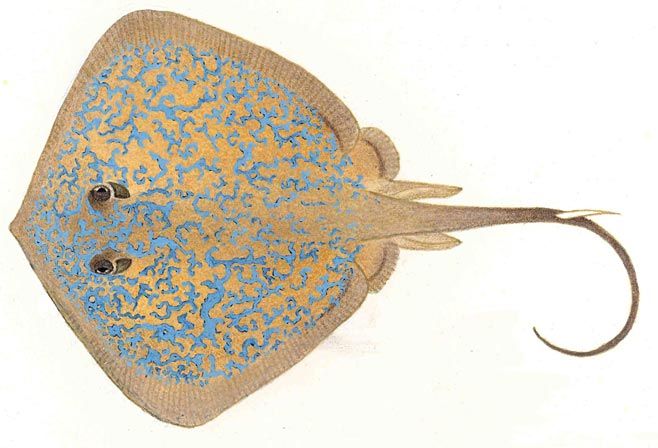|
Dasyatis chrysonota (Blue stingray)
(Smith, 1828)
Life
> Eukaryotes >
Opisthokonta
> Metazoa (animals) >
Bilateria >
Deuterostomia > Chordata >
Craniata > Vertebrata (vertebrates) > Gnathostomata (jawed
vertebrates) > Chondrichthyes > Elasmobranchii > Batoidei >
Myliobatoidei >
Dasyatidae
 |
|
Dasyatis chrysonota (Blue stingray) [Illustration
by Ann Hecht ©] |
Identification
An angular stingray with conspicuous bright
blue blotches and branching lines on a golden brown disk. Snout and
disk angular, tail less than twice body length, a short upper caudal
finfold and a longer lower one which falls far in front of tail tip,
disk without thorns, and usually 1 sting. Underside white, tail
darker and without bands.
Size
To 1.5 m TL and 75 cm DW.
Range
Most of the area from Namibia to Natal; Eastern Atlantic from
Senegal south to the area.
Habitat
Close inshore, often off
sheltered sandy beaches and in shallow bays, but also outer shelf
down to 109 m.
Biology
Very common in the surf zone, feeds on
swimming crabs, mole crabs, mysids, shrimp, mantis shrimp,
amphipods, polychaete and acorn worms, and small fishes. Bears 1 to
4 young. Moves inshore off beaches in summer, offshore in winter.
Human Impact
A popular sportfish, commonly caught by rock and surf
and skiboat anglers but generally released after capture. Formerly
confused with the European stingray (D. pastinaca), which does not
occur in the area.
Text by Leonard J.V. Compagno, David A. Ebert
and Malcolm J. Smale
|
